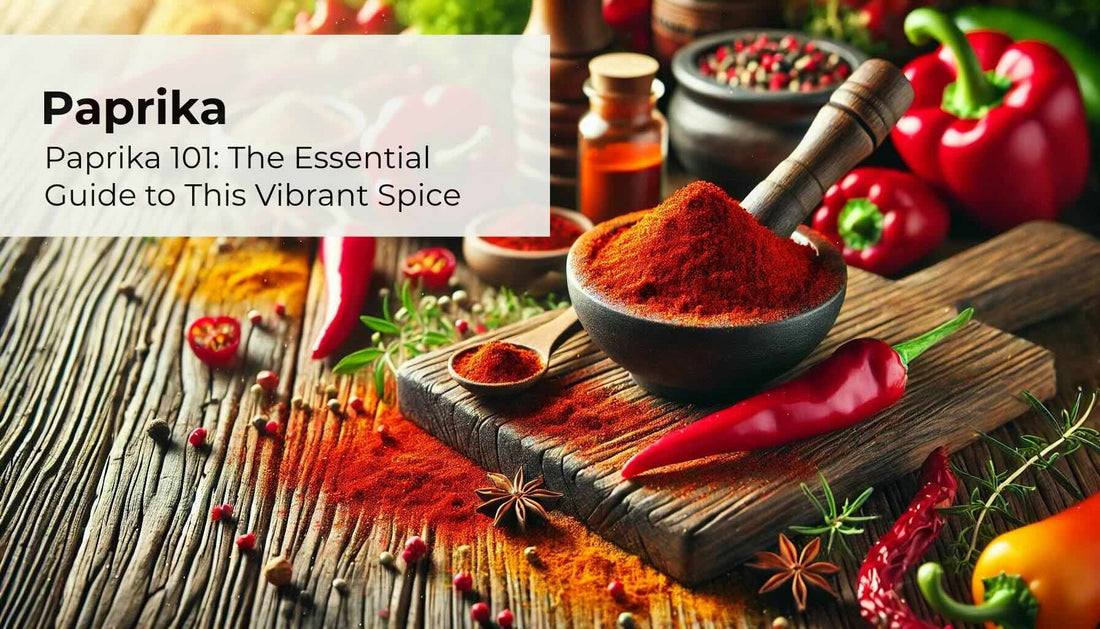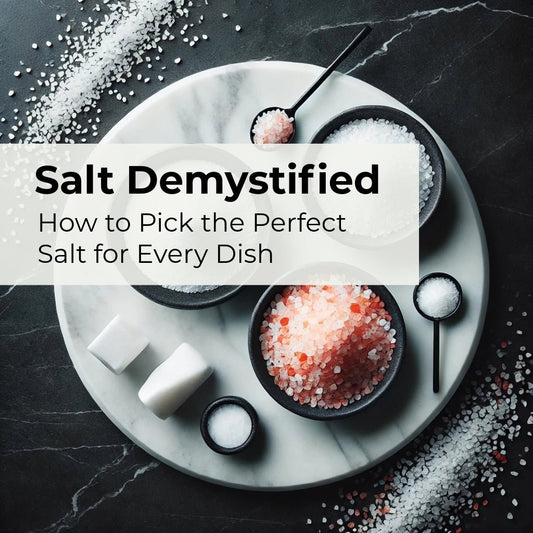
Paprika 101: The Essential Guide to This Vibrant Spice
Share
Table of Contents
- Origin and History
- Types of Paprika
- Cultural Significance
- Health Benefits
- Culinary Uses
- Paprika’s Popularity and Market Share
- How to Store and Use Paprika
- Uses of Paprika Outside the Kitchen
- Conclusion
1. Origins and History
Paprika's journey began in Central America, where indigenous peoples first cultivated a variety of peppers. The peppers used to make paprika are typically cultivars of Capsicum annuum, which includes a wide range of pepper varieties. These can range from mild and sweet, such as pimiento, to more pungent types, rather than just bell peppers as often mistakenly believed. When Christopher Columbus brought these peppers back to Europe, they quickly gained popularity. By the 17th century, paprika became a staple in Hungarian cuisine, where it is now a national spice.

2. Types of Paprika
Paprika comes in several varieties, each with distinct flavors and uses:
- Sweet Paprika: Known for its mild flavor and vibrant red color, commonly used in Hungarian goulash.
- Smoked Paprika: This variety has a smoky flavor, achieved by drying the peppers over wood fires, and is a key ingredient in Spanish dishes like paella.
- Hot Paprika: Made from spicier pepper varieties, it adds heat to dishes and is popular in regions that favor spicier food.
3. Cultural Significance
Paprika is a cornerstone of Hungarian cuisine, where it’s called the “national spice.” The spice is also integral to Spanish, Portuguese, and Moroccan cuisines, enhancing the flavor and color of traditional dishes.
4. Health Benefits
Paprika is not only a flavor booster but also offers several health benefits. It is rich in antioxidants, particularly carotenoids like beta-carotene, which can promote eye health. Additionally, paprika contains capsaicin, a compound that may help reduce inflammation and pain. Sources (discussing the benefits of :
- Antioxidant effects of carotenoids in vivo and in vitro: an overview - This study discusses the antioxidant properties of carotenoids, including beta-carotene, which is present in paprik
- Capsaicinoids and Their Effects on Cancer: The “Double-Edged Sword” Postulate from the Molecular Scaleps - This paper covers the effects of capsaicin, including its potential to reduce inflammation.
5. Culinary Uses
Paprika is a versatile spice used in various dishes. It’s often sprinkled over deviled eggs, mixed into rubs for meats, or stirred into stews and soups for a burst of flavor and color. Some famous dishes that utilize paprika include:
- Hungarian Goulash: A traditional Hungarian stew made with beef, vegetables, and a generous amount of sweet paprika, which gives the dish its characteristic red color and depth of flavor. Recommended recipe
- Spanish Paella: Smoked paprika is a key ingredient in many variations of paella, adding a smoky flavor to the rice and seafood dish.
- Deviled Eggs: Paprika is often sprinkled on top of deviled eggs as a garnish, adding both color and a mild, sweet flavor. Recommended recipe
- Chicken Paprikash: Another Hungarian classic, this dish features chicken cooked in a creamy paprika sauce, usually served over noodles or dumplings. Recommended recipe
- Chorizo: Spanish chorizo, a type of sausage, often includes smoked paprika in its seasoning blend, contributing to its distinctive flavor and red color. Recommended recipe
6. Paprika’s Popularity and Market Share
Paprika is one of the most widely traded spices globally, with significant production and export from countries like Hungary and Spain. While it doesn’t dominate the spice market as much as black pepper, cumin, or turmeric, it holds a strong position, particularly in European and Latin American markets. In terms of global popularity, paprika is often ranked among the top 10 spices used in cooking, especially noted for its ability to add color and flavor without overpowering other ingredients.
7. How to Store and Use Paprika
To maintain its flavor and potency, paprika should be stored in a cool, dark place, away from heat and light. It’s also recommended to buy paprika in smaller quantities and use it within six months to a year, as the spice can lose its potency over time.
8. Uses of Paprika Outside the Kitchen
Paprika isn’t just for adding flavor and color to your food—it has applications beyond the kitchen as well. One of the lesser-known uses of paprika is as a natural dye. Thanks to its vibrant red and orange hues, paprika can be used to dye fabrics, fibers, and even cosmetics.
- Natural Dye for Fabrics: Paprika can be used to create natural, earthy shades of red and orange when dyeing fabrics. This eco-friendly alternative to synthetic dyes is especially popular among artisans and those interested in sustainable fashion. The dyeing process typically involves boiling paprika in water and then soaking the fabric in the solution to achieve the desired color.
- Cosmetics: Paprika is sometimes used in natural cosmetics for its coloring properties. It can be found in certain lip balms, blushes, and other products where a natural red hue is desired. However, it’s important to note that the concentration of paprika in these products is carefully controlled to avoid skin irritation.
Paprika’s vibrant color and natural origin make it a versatile option for those looking to add a touch of natural beauty to their creations, whether in textiles, art, or personal care products.
Conclusion
Paprika is more than just a spice; it’s a cultural symbol, a health booster, and a versatile ingredient that enhances countless dishes around the world. Whether you’re using sweet, smoked, or hot paprika, this spice is sure to add a vibrant touch to your cooking. From its origins in Central America to its essential role in European and Latin American cuisines, paprika continues to be a beloved spice with a rich history and a bright future in kitchens worldwide.









